Crunchy outside, fluffy and a little bit sweet inside. Korokke (コロッケ, potato and ground meat croquette) is one of the very popular Japanese home cooking dishes. Have it with tonkatsu sauce (sweet Worcestershire sauce).
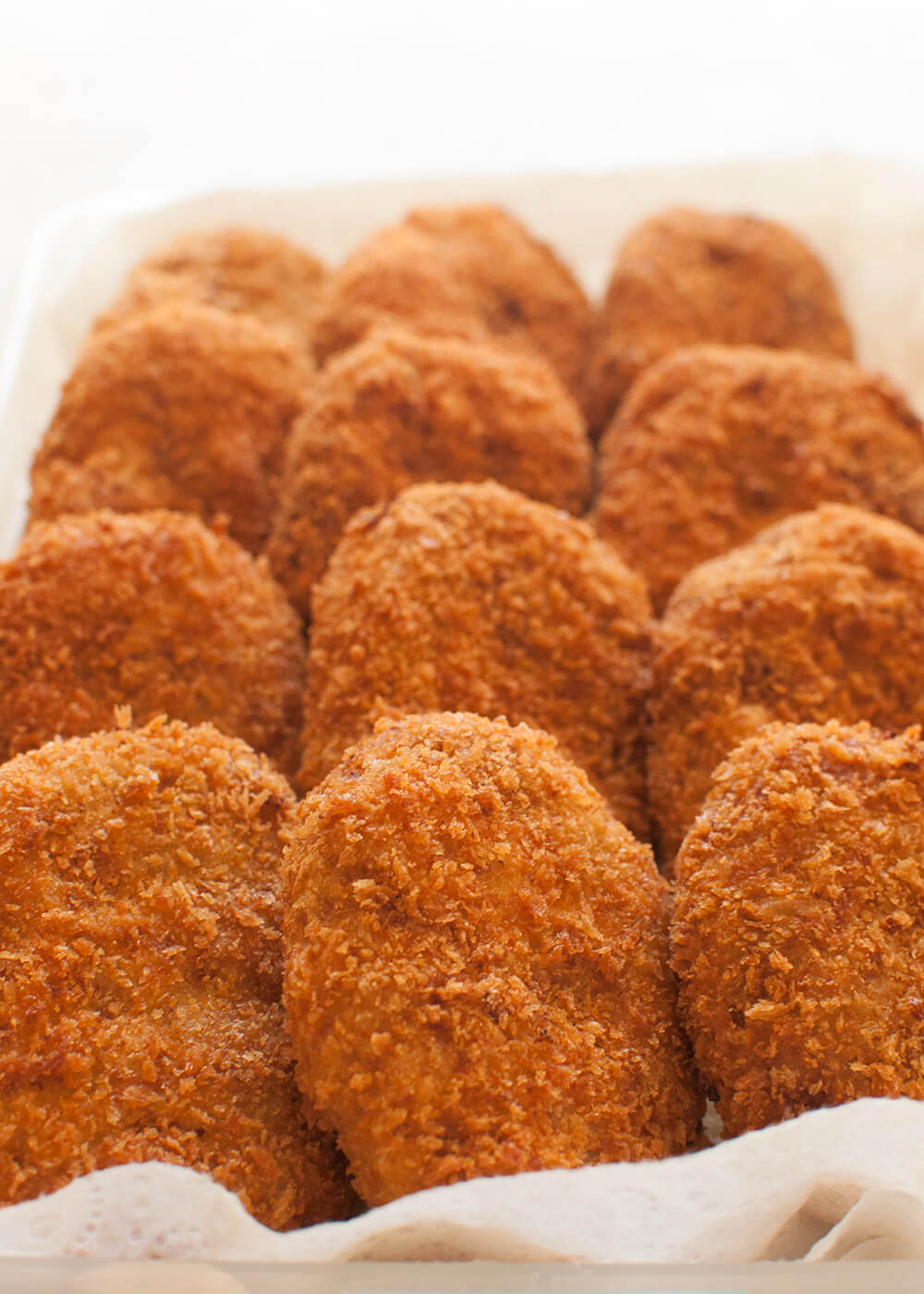
Korokke (コロッケ, potato and ground meat croquette) is somewhat different from any other croquette. Nothing is so satisfying than taking a big bite into a freshly fried hot korokke.
The name korokke came from the French dish croquette, by converting the sound into something similar and easier for Japanese people to pronounce. That’s why the word is written in katakana, which is a set of phonetic characters to express sounds and foreign words, instead of kanji characters. If you compare the sound of croquette and korokke, you can hear the similarity, can’t you?
While the French croquette is made with béchamel sauce, the inside of the traditional korokke is mainly potato with small amount of ground meat and onion. The potato mixture is flavoured with typical Japanese seasonings such as soy sauce, sake and mirin.
Korokke is also coated with panko breadcrumbs, which are much more coarse than usual breadcrumbs and make the outside of korokke very crunchy when deep fried.
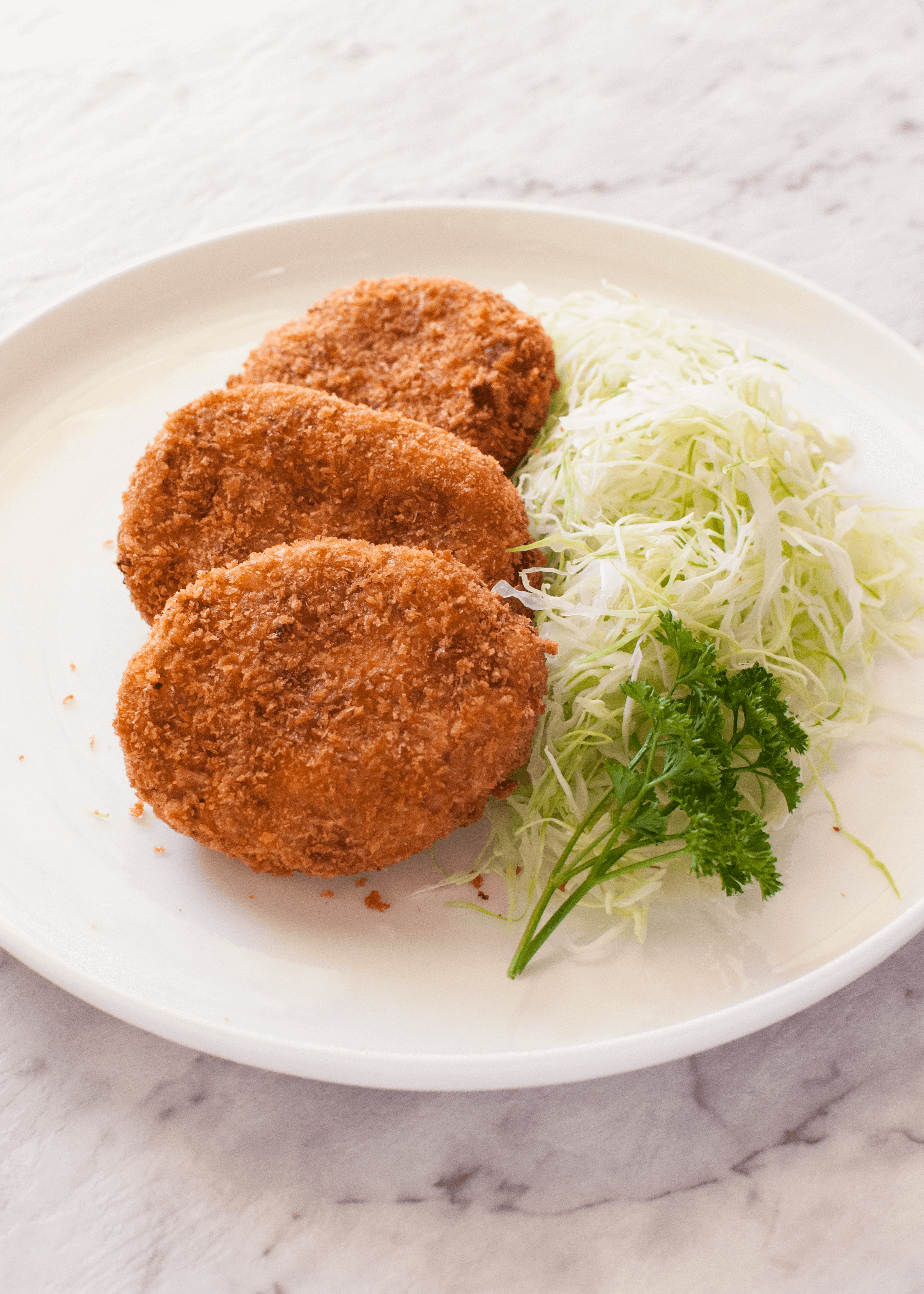
Although traditional korokke was made of potato, onion and ground meat; nowadays korokke comes with vegetables and seafood instead of meat; and also béchamel sauce instead of potato.
The shape of korokke also varies. Instead of the flat oval shape which is the traditional korokke as in this recipe, you may have the flat round shape, the log shape and the ball shape.
Korokke was one of the regular dinner menus in my household when I was a child. In fact, it was probably the case in many households at that time. Even now, I believe korokke is a popular dinner dish.
If you live in Japan, you probably do not make korokke like I do in Sydney because you can buy delicious korokke at shops and they are not expensive at all. When I was a child, korokke was sold at the butcher. They made korokke from scratch with secret seasoning. Then, they deep fried it with panko breadcrumbs in front of you.
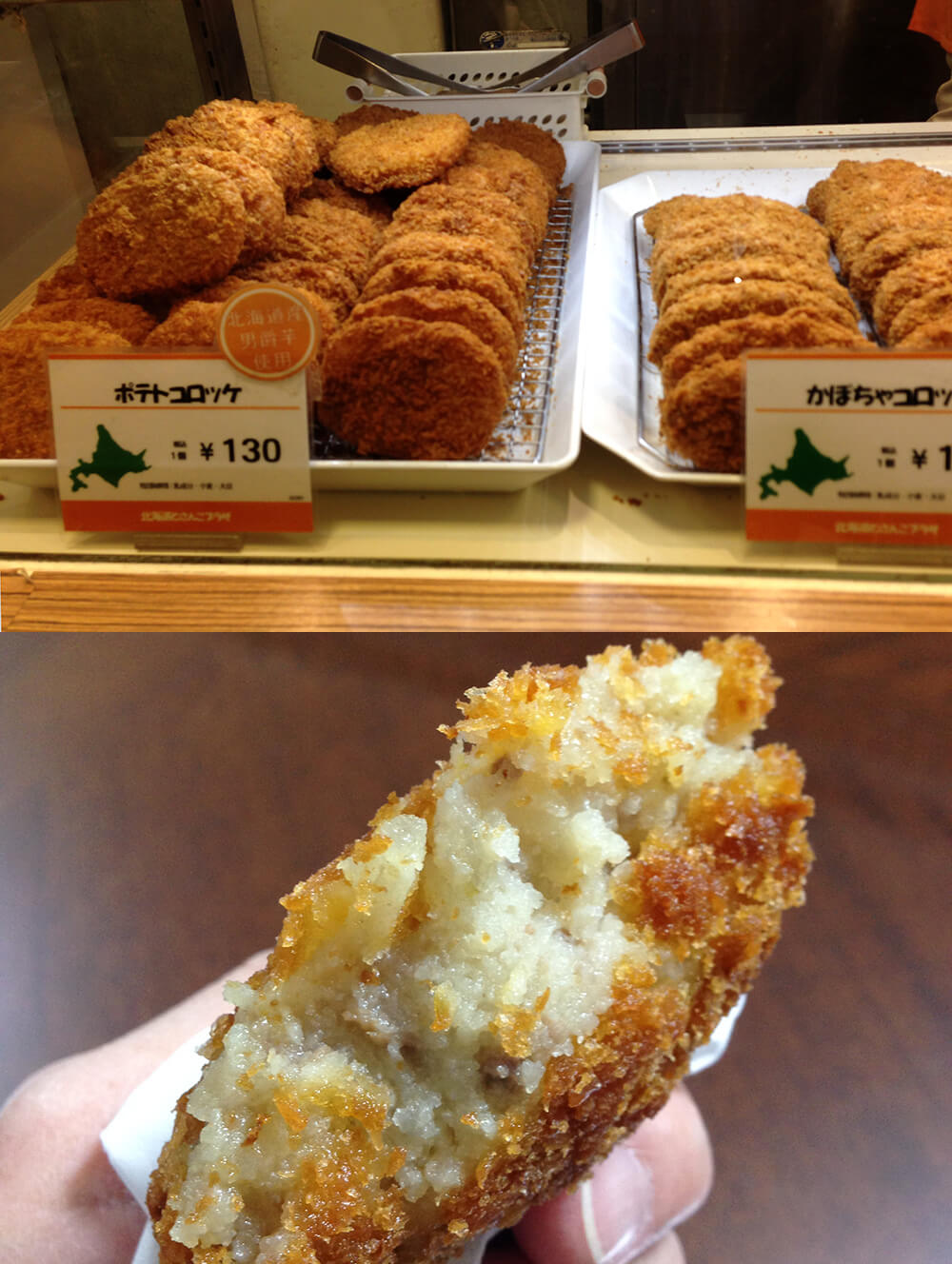
This tradition still exists and you can buy korokke at most butchers. But korokke is also sold at specialty shops and super markets. I still prefer buying korokke from a butcher, though. I don’t know why but it tastes better in my view, perhaps because a korokke is freshly made.
Whenever I returned to Tokyo to see my parents, I never missed buying a korokke from the butcher my parents used to buy meat from. And I ate it while walking back to my parent’s house. It was so good.
My parents were very conservative people. Given that they were both teachers, they valued morals and were very strict with manners. When my mother saw me eating a korokke while walking along the street, she almost had a fit. She said that it was disgraceful to eat food while walking, not to mention outside in public. I countered saying that it’s the norm in Australia. She rolled her eyes.
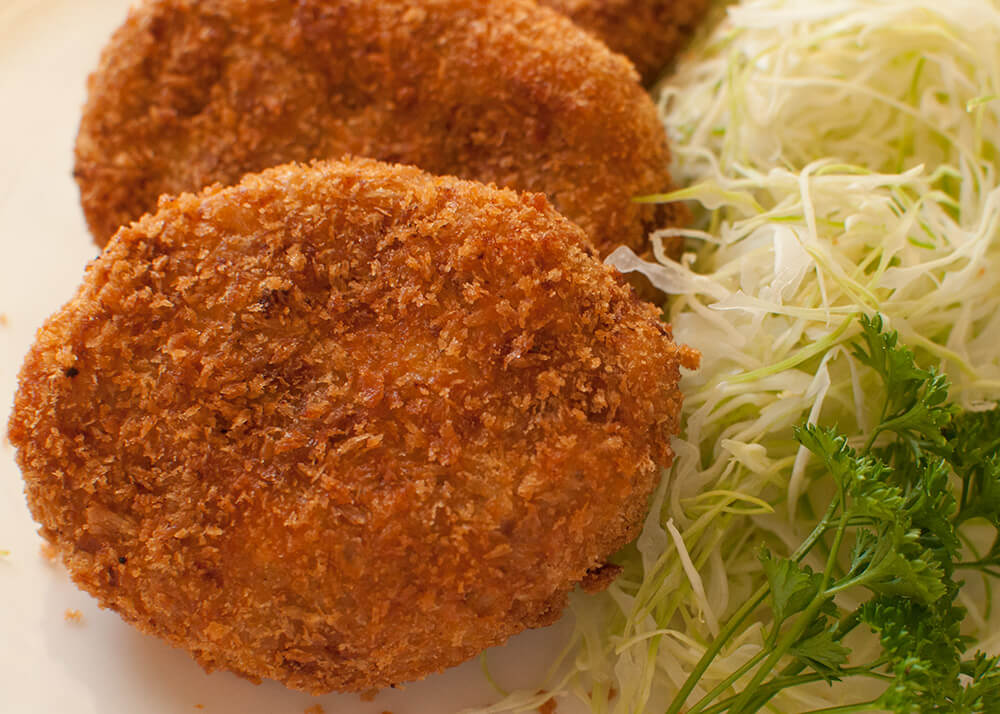
But I think korokke is one of those things that tastes best when you eat it immediately after deep fried, especially while walking. It’s just like a McDonald’s hash brown. The pattie has flavours so I don’t even use sauce if I eat korokke like this.
In addition to the texture of breadcrumb, what makes korokke so different from croquette is that korokke is slightly sweet inside. It took me a while to get the flavour close to those you can get from the butcher in Japan, but I think the korokke in this recipe is pretty close.
If you ever visit Japan, try a hot korokke from a butcher or a specialty shop. You will know exactly what I mean.
Yumiko![]()

- 600g/1.3lb starchy potatoes (note 1)
- 1 tbsp oil
- 200g/0.4lb pork mince (ground pork) (note 2)
- 1 small onion finely diced
- Salt & pepper
- 50g/1.8oz flour
- 1 beaten egg
- 2 cups Japanese bread crumbs (note 3)
- Oil for deep fry
- Shredded cabbage
- Parsley leaves
- Tonkatsu sauce (note 4)
-
Put potatoes in a saucepan and add water to cover the potatoes sufficiently. Turn the heat on high and bring to a simmer.
-
Cook potatoes until a bamboo skewer or a thin knife can get through to the centre of the potatoes easily. This will take 15-40 minutes depending on the size of the potatoes (note 5).
-
When the potatoes are cooked, drain into a colander. Peel the potatoes immediately and place them into the saucepan just emptied. It is very hot so use a cloth or layers of kitchen paper to hold the potatoes.
-
Using a potato masher, mash the potatoes mostly but leaving some tiny chunks of potatoes.
-
While boiling potatoes, heat 1 tablespoon oil in a fry pan over medium high heat. Add onion and sauté until the onion becomes translucent and soft (about 3-5 minutes). Add pork, salt & pepper and cook, breaking it up as you go until browned and cooked through.
-
Add the cooked mince to the potatoes in the pot (discard oil if accumulated in the fry pan), then the Korokke Flavouring ingredients. Mix well (note 6).
-
Divide the potato mixture into 12 equal balls. Flatten them and shape into oval patties, about 2cm/¾” thick.
-
Place flour, egg and breadcrumbs in a shallow plate or bowl individually.
-
Coat each patty with flour, egg, then breadcrumbs.
-
Heat oil in a deep fry pan over medium heat. Fry the patties for 1-2 minutes until the breadcrumbs become golden brown. You can fry more than one patty at a time but do not overcrowd the fry pan.
-
Serve immediately with shredded cabbage with a stem of parsley leaves, accompanied by tonkatsu sauce.
1. Starchy potatoes are best suited to this dish as they become nice and fluffy when cooked. The best to use are Russet (common in the US), Dutch Creams, King Edward or Red Delight. However, great all-purpose potatoes like Golden Delight, Coliban, Red Rascal and Sebago (popular in Australia) still work great.
2. Today, I used just pork mince but usually I use mixture of pork and beef mince. You could even use chicken if you like.
3. The quantity of breadcrumbs required is approximate as it varies depending on how much you coat the patties.
You can use normal breadcrumbs but the texture of outside would be different from korokke. Japanese breadcrumbs are much more coarse than standard breadcrumbs, hence they create a crunchier texture when cooked, which is the best part of korokke.
If you can’t find Japanese breadcrumbs at Asian grocery shops, you can make them by placing stale white bread in the blender and coarsely grinding it.
4. I think that thick fruity tonkatsu sauce goes well with korokke. Please see my post, Yakisoba for more details about Japanese sauce. You can also see the tonkatsu sauce bottle in the photo below this recipe.
But if you don’t have it, a mixture of Worcestershire sauce and tomato sauce (ketchup) can be a good substitute.
5. If you don’t have time, you can cut the potatoes into 2.5cm (1”) cubes, then boil in a pot of water just to cover the potatoes. When the potatoes ae cooked through, drain the water leaving the potatoes in a pot. Shake the pot over high heat for 15-20 seconds to evaporate excess moisture.
6. At this point, try to forma a patty to check the consistency of the potato mixture. If too dry, it tends to crack the edges of the patty and you need to add a bit more milk (not in ingredients) to make it moist.
7. You can breeze Korokke before deep frying. Individually wrap Korokke and place them in a ziplock bag and freeze.
Do not thaw Korroke before frying as the moisture form the Korokke makes it difficult to deep fry. Fry either frozen or slightly thawed in microwave.
The temperature of the oil should be about 180C/320F. Fry only a couple of Korroke at a time and do not turn them over.
When the centre of the Korokke is softened, it is ready.
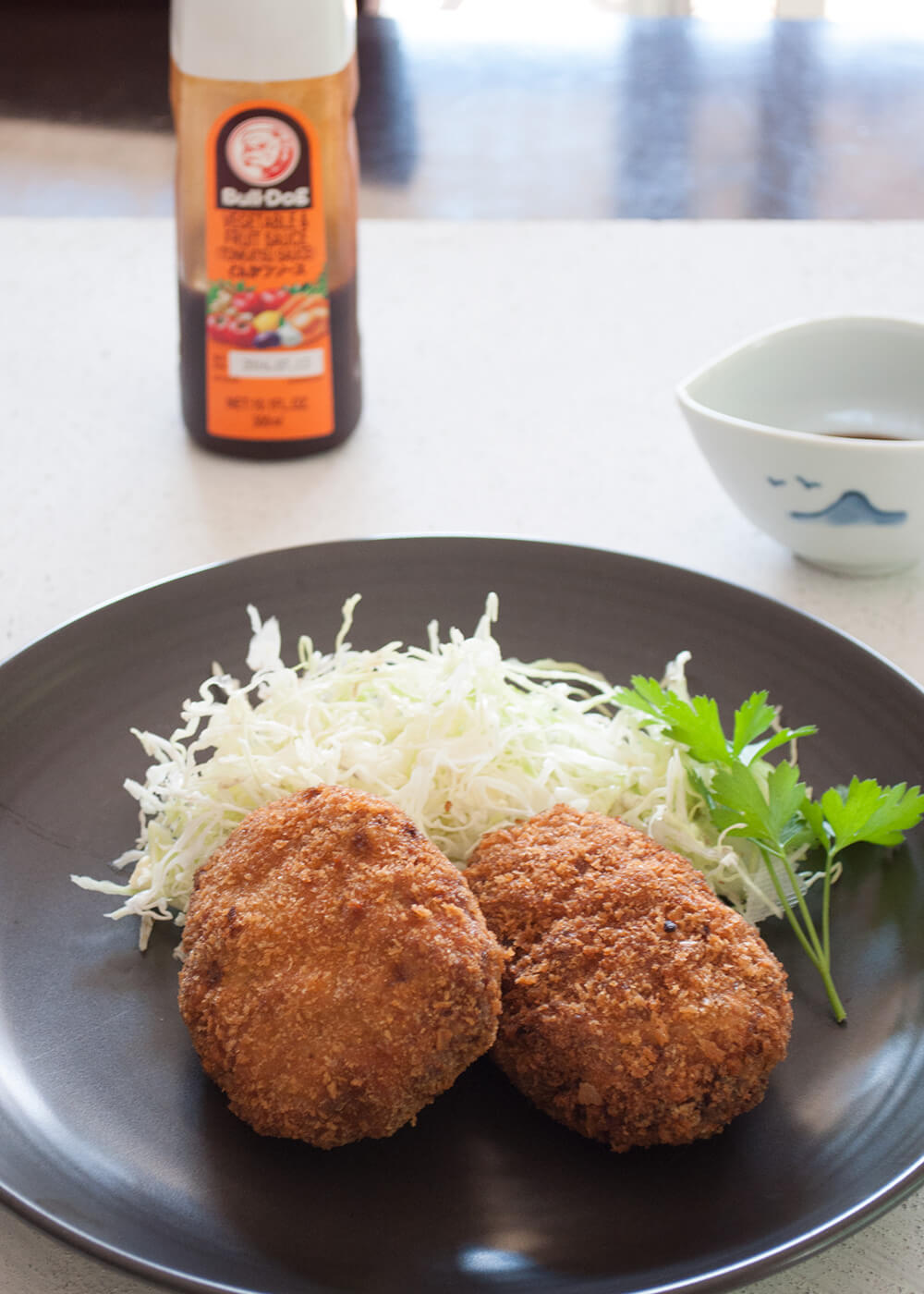
Hi Yumiko!
I made this delicious recipe of yours last night and, as expected, DELISH! I seemed to run into the same issue as others (mixture too dry, cracking), but didn’t catch the tip of adding more milk >_<
Great texture fresh out of the fryer, and even pretty good the following day for lunch. Quynh says "YESSSS! This is the best! I would eat this 10 times out of 10."
Thank you for your hard work!
Hi Joey, I am glad you enjoyed Korokke. Now that few people mentioned about cracking the edge, I think I should add a note about adjusting the consistency with milk. Thanks for mentioning this.
Fantastic recipe and so easy. Everybody loved it
Hi Elfi, thank you! Glad it was a hit.
Hello Yumiko!
I had some leftover mashed potato in my fridge and was trying to decide what to do with it, when I remembered reading your recipe.
It was delicious. Everyone in my family enjoyed it, even the 3 year old and 8 year old.
I found my mixture was a bit hard to shape, but I think maybe that was the milk in my mash. Nevermind. Next time I’ll make them ahead and pop in the fridge. I don’t really deep fry, but I did shallow fry some like I would schnitzel and I also put some in my air fryer. The air fried ones had a better crunch, imo. Still lovely, lovely.
No one here seems to like raw cabbage, so I served it with one of my favourite raw beetroot and carrot slaw.
Thank you for a wonderful meal.
Hi Claire, that was a great idea to use leftover mashed potato! I’m glad that your family liked korokke. Korokke is my family favourite, too. Every time when I mentioned ‘korokke for dinner’, my kids eyes lit up.
Hello yumiko, a few days ago I tried this recipe and although quite simple it was delicious. However, I had some problems with the croquettes before frying them since they were cracked a bit, I will have to add more water?
Also, as I had already commented in another post, I made takoyaki and the sauce I bought from Japan says it is sweeter and more fruity than standard takoyaki sauce, could it serve as a substitute for tonkatsu sauce?
This is a photo of the back of the package:
https://ssli.ebayimg.com/images/g/EUwAAOSwNSxVZVld/s-l1600.jpg
Hi Ruth, if you’re feel that the potato mixture was on dry side, you could add a bit of milk. You could also cool the mixture down in the fridge which makes the mixture firmed up, easier to form an oval shape.
You can use takoyaki sauce as an alternative. If you find that it is too sweet, you might want to add Worcestershire sauce to adjust.
Hi Yumiko, thanks for the reply.
I have already done Korokke several times and I thought about looking for some interesting variation and then, a few days ago I found a Japanese recipe of “牛 す じ 煮 込 み” and suggested adding the leftovers of this to Korokke, the problem is that I used 牛 す じ but I don’t know how it translates.
Could you help me know what meat cut is this?
Hi Ruth, 牛 す じ is beef tendon. But in Japan, tendon comes with a bit of meat attached to it so it’s not just gelatinous tendon which is often the case (at least in Sydney). Because it is tendon, they need to be cooked for a while to make it tender.
Hello! I made this recipe today! I have never fried anything before, so it was a little scary, but the final product came out really tasty. I put cheese and corn in half of them. One problem I had was that even though I shaped my potato balls into patties, they cracked sometimes. It was difficult to mash my patty back together. I think this is because I am still very inexperienced. Do you have any tips for that part?
Thank you for the recipe. I will definitely make it again!
Hi Mel, I am glad you enjoyed Korokke. There are a couple of things you can do to avoid clacking when flattened the balls into patties. (1) When the mashed potato mix is very dry, it tends to clack. You can add small amount of milk to make the potato mix a little bit softer. (2) After flattened, punch where the cracks are to close them, then place the pattie on your left hand (for right hander) vertically across the palm. Then place your other hand over the patty cross wise, as of you are wrapping the patty with your hand. While gently squeezing the left hand to keep the pattie flat, smooth the surface of the round edge with your right hand. This is the same movement to making Onigiri (Japanese Rice Ball) – watch the video at the end of recipe.
Hi Yumiko!
Just wanted to let you know how profoundly grateful I feel of you sharing your recipes. Love the pictures too, I can almost smell the delicious aroma. Takes my mind and tastebuds back to Japan ❤️
Thank you, Julieta! Now you can produce delicious aroma in your kitchen.
Can you bake this because my family do not like anything fried due to health reasons.
Hi Bev, I never tried baking method but there is no reason why you can’t to do that. All ingredients are already cooked and deep frying is just to give crunchy outside and golden colour to the korokke.
If you spray the tray with oil, place korokke, spray oil on the surface, then bake until golden brown.
Hi, Yumiko. I was a flight attendant and went to Narita quite often and i used to go to the large grocery store and buy an aubergine/eggplant dish that they sold in the food section . It was absolutely deelicious. I remember that it was half a small eggplant with filling and i think covered in bread crumbs or batter and came in styrofoam, cling wrap covered packs of three and i do know it was seasonal as I tried to get some when eggplants weren’t available and was told this by one of staff (who, lucky for me spoke english). I didn’t remember the name of it so i tore the label off and carried it with me for ages so when I returned to Narita (quite often) I used to show it to shop staff if I couldn’t find it on the shelf and from memory it was the only eggplant dish available. I know I’m asking alot as this goes back 13 to 17 years ago but would you have an idea what it was and do you have or can you get a recipe for it (that’s if you know what it is). I would love to make it . I’ll thank you for your efforts in this endeavour and hope to hear from you soon. Regards frank
Hi Frankie. That’s a bit of a challenge for me but I wonder if it is “nasu no hasamiage” (ナスのはさみ揚げ, deep fried stuffed eggplants). Usually filled with minced (ground) pork or chicken between the vertically sliced eggplant, coated with either panko breadcrumbs or flour and deep fried.
If you google search images with this Japanese name, ナスのはさみ揚げ, you will see variations of this dish.
Please let me know if that’s what you are after. You reminded me that I used to make this, too. I should post the recipe soon.
Hi Yumiko. You are AWESOME. Thanks for the quick reply and will look up the recipe site. The supermarket that I bought the eggplant dish from was JUSTCO and an ex- flying mate just told me it’s been demolished for about 4 years, a pity. I will let you know if I have found the right recipe. Please keep on adding your 100 yens worth to this site as it’s most appreciated because old recipes in whatever country should never be lost because the people had to make the flavour without all the new and diverse ingredients we have now. I know time today is a factor but some of us like to dabble. Thanks Frank.
You are welcome.
So lovely! This post sure makes me miss living in Japan. The kabocha korokke were my absolute favorite. I always snagged them from Tokyu grocery store after a long day. I made my own baked version, but nothing beats freshly fried korokke! 🙂
Hi Caitlin. Thank you! Korokke is so addictive, isn’t it?
Hi there, these look yummy! My husband is allergic to egg, have you got any suggestions on how to coat it without the egg so that the crumbs still stick?
Hi, Kerryn. In this recipe, I separated flour and egg to coat korokke before putting breadcrumbs on. But when I am in a hurry or feel lazy, I do a shortcut by mixing flour and egg together with a bit of extra water to make the mixture the consistency of thick cream. this will reduce the coating steps.
So my suggestion would be to mix flour and water in place of flour then egg. Coat korokke with this mixture then breadcrumbs. It should still be yummy and you get it done faster!
Kerryn – You could also try making a “flax egg” by mixing 1 Tablespoon ground flax seed with 3 Tablespoons of cold water. Mix and let rest in the fridge for 15 minutes. I use this method for kids with egg allergies and it seems to work pretty well!